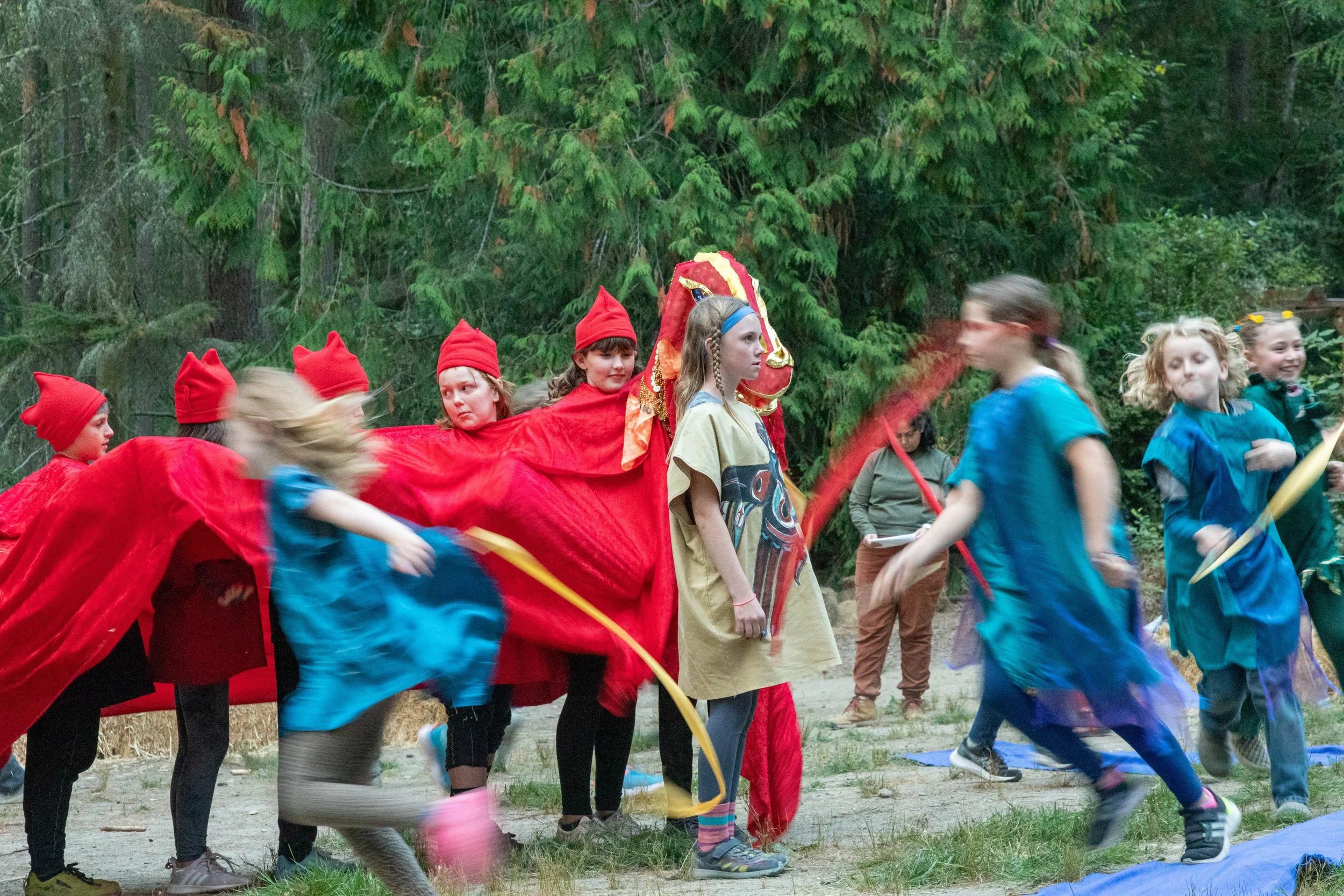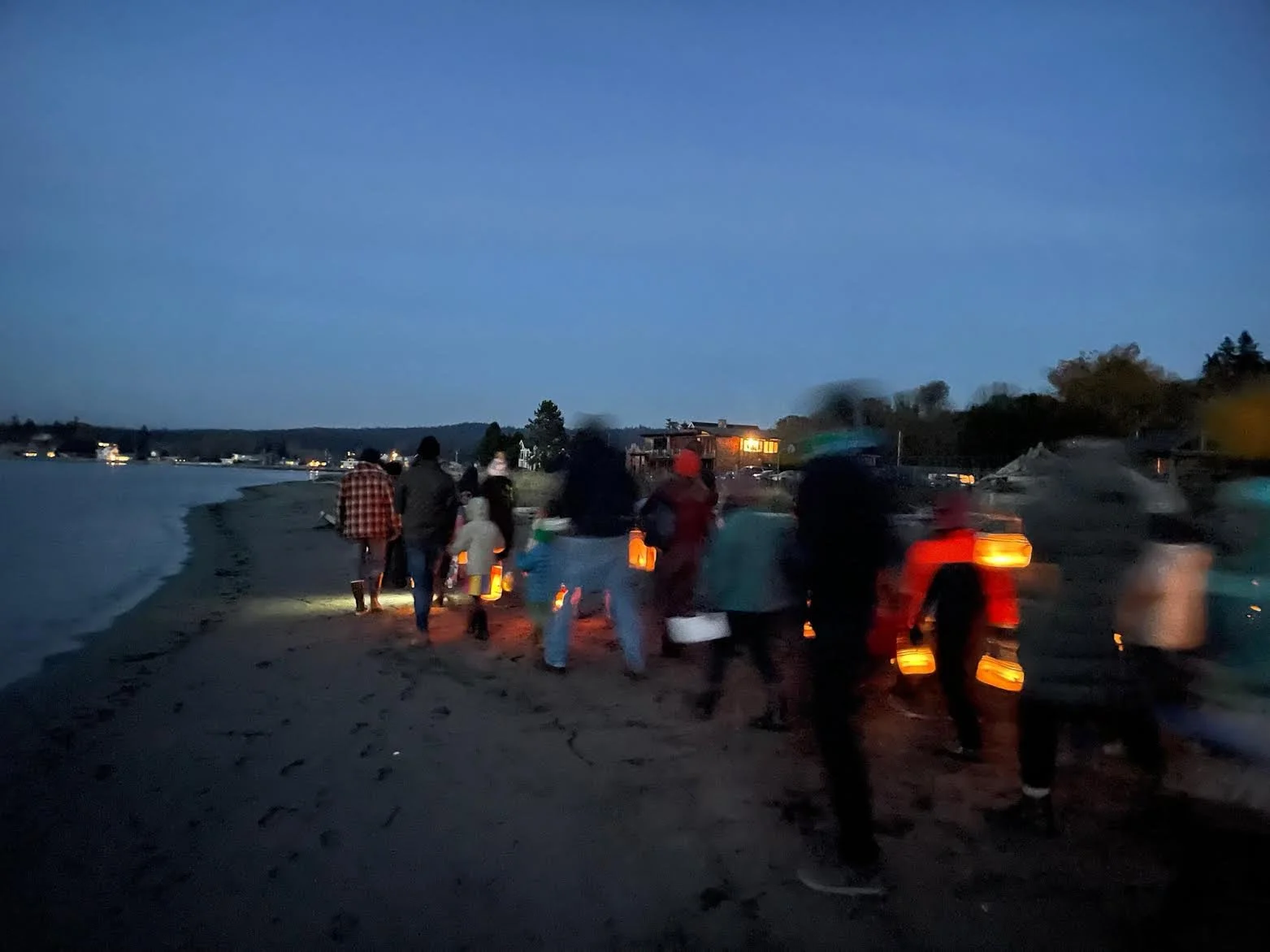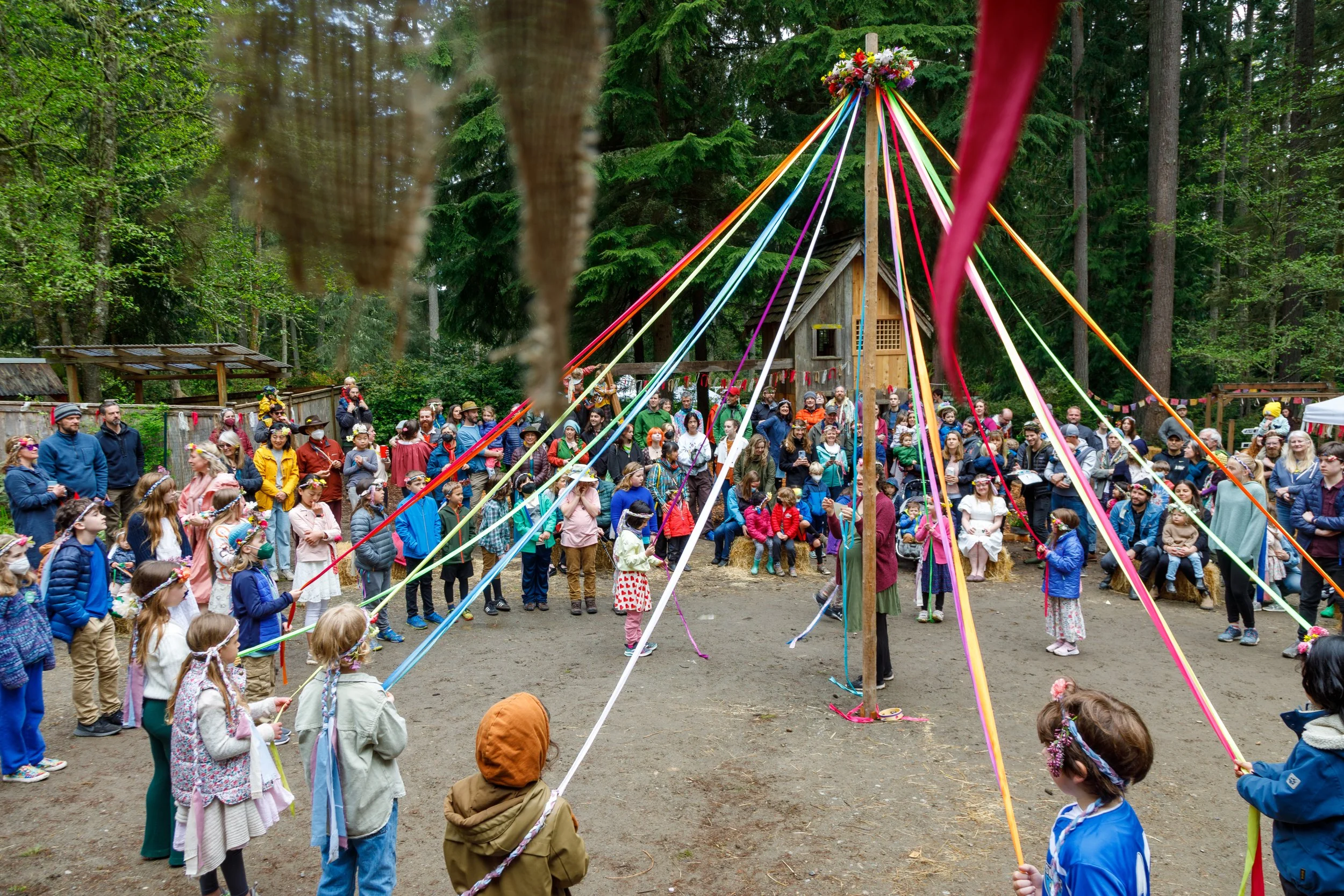To learn more about Whidbey Island Waldorf School or come for a tour or a walk through the Grades, please reach out through the button below.
yearly Festivals at WIWS
Festival of courage
Quarlo and The Dragon of Tamanowas Rock
Our Grades 1-7 pageant is based on an indigenous story from Pt. Townsend, adapted into a play last year by our Grades Pedagogical Administrator, Angela Sha'nung Quae Lindstrom.
This offering is a renewed vision of Michaelmas, to reflect our local culture, time and place.
"What happens when a place loses its stories? It must be like a person going dumb. Stories that explain or “locate” the landscape, as this one does, are especially momentous because they embody a collective wisdom; the experience of living in a particular place worked and reworked so that the story that emerges from generations of telling is as elegant and weather-worthy as a Nootka canoe. When we tell these old stories they carry the human imagination. They are its craft. They mold our fit with the local earth. Indeed these old stories become synonymous with the places they invoke; the dragon and Tomanawos Rock are the left and right eyes of a deeper seeing. When we forget the stories, the landscape ceases to speak to us. When we ruin the character of a place, then the story becomes quaint, “superstitious.”"
–from the story of No-Qui-Klos, rewritten and published by Wild Olympic Salmon (now North Olympic Salmon Coalition) for all the people to hear.
Festival of Advent & The winter spiral
The advent journey is an opportunity to reconnect with our own inner light, to celebrate our connection to the natural world, to one another, and to the world of spirit.
At Waldorf Schools around the world, children walk a Winter Spiral of evergreens. They light a candle from a central light source and share that light with the world. This resonates with the many festivals of light in world cultures that celebrate the power of our individual and collective lights as we celebrate the beautiful dance of darkness and light.
Seasonal rhythms live deep within us and orient us in time. With these rhythms comes faith that the cycle of the seasons will go on: faith that the leaves will fall and the rains will come to renew the earth, faith that cold and darkness will blanket the plant and animal world as we come into an essential time of rest, and faith that the sun will return to warm the soil.
As winter approaches in the Northern Hemisphere, Nature’s mood grows sleepy. Through the stories, poems and songs we bring, and their own observation of nature, the children experience a settling down, a feeling of being blanketed for a winter’s nap. Fallen leaves, hibernating animals, and short daylight hours contribute to an experience of going inward.
The word ‘advent’ comes from the Latin word adventus, meaning ‘that which is coming’. In Christian traditions it refers to the four Sundays before Christmas. However, from earliest times humans have observed Nature’s seasonal transitions. Advent time balances the deep renewing darkness with anticipation of the yearly rebirth of the light. The Jewish celebration of Hanukkah's miracle of light falls at this time of year. The Hindu festival of lights, Divali, has just passed. Many earth-based traditions honor the Winter Solstice with special joy.
Rudolf Steiner describes festivals as ‘Shining Days’ interwoven with the cycles of nature, celebrating the human being’s connection between earth and the realm of spirit. At our school we continuously cultivate a sense of reverence for all the beings of Nature. During our three week festival of advent, we deepen our relationship to the natural world by recognizing and celebrating the strength and beauty in each of the Earth’s realms.
In the first week we honor the mineral realm; the rocks, shells, crystals, and bones which give structure to the Earth and to our physical bodies.
In the second week we give gratitude to the plant realm from which we receive nourishment and share the forces of life itself.
In the third week we celebrate the realm of animals with whom we share the capacity for movement and a feeling soul.
The fourth week of advent speaks to the unity of humankind. As we pass through these weeks, we are moved toward a deeper understanding of our place in the universe, of all that supports us, and all that we aspire to as well as all that needs our care and protection.
The importance of Festival Life
At WIWS and in Waldorf schools across the world, the elements of festival — changing of the seasons, community in gratitude and celebration, song, story and sometimes silence — permeate the life at the school, and help establish the cadence of the year.
Throughout history and in all civilizations, there are rituals reflecting nature’s rhythms, important transitions, and significant moments in the cycle of the year and the life of the culture. For people today, festivals can help provide a real touchstone with the cycles of the earth and the soul nurturing they provide. Reverence, ritual and rhythm are three integrated aspects of Waldorf education.
In the speed and busyness of our contemporary world, it often helps to be reminded of more enduring values, and our capacity for reverence. Establishing an environment in which each day is rhythmically ordered and the year is marked at special moments with rituals and celebrations helps create a secure foundation from which to grow.
The sense of the sacred at the school is a recognition that time doesn’t just pass, it is taking us somewhere. The Waldorf seasonal festivals mark this journey in a way that resonates with the journey of other peoples across time and suggests meaning and mystery.
dia de los muertos
In the Mexican culture, Dia de Los Muertos celebrations occur between October 28 and November 2, depending on the particular customs of the region. Each day is designated to welcome the arrival of spirits. October 31st to November 1st is reserved for “Los Angelitos”, the spirits of young children. November 1st to 2nd is reserved for the spirits of adults.
Egyptian, Celtic, Roman, English, Aztec, and Maya cultures all share traditions commemorating the harvest and death. Dia de los Muertos grew from the blending of Aztec beliefs and rituals with the Christian All Saint’s Day and All Souls’ Day. The result is a unique mix of the solemn and respectful, the festive and whimsical.
Today, you will find different celebrations amongst the many Spanish-speaking countries. The holiday may range from a visit to the cemetery to clean and decorate the graves to all-night vigils, picnics, music, and neighborly visits at the cemetery.
In Mexico, families might build a family altar in their home. Markets fill with traditional flowers, candy skulls and amusing skeleton figures. Larger sculptures of skeletons mimicking human activity are on display in public parks and museums along with altars and plays with political overtones.
Dia de los Muertos has been celebrated
at WIWS since 1997.
Since its beginning as a table covered with tea lights in the lobby, it has grown to be a beloved celebration by children and adults alike. Through the Spanish program, the students learn about Mexican culture, and help to create many of the traditional elements of the “ofrenda”, such as paper marigolds, papel picado, tapetes, sugar skulls, pan de muerto, and more.
One thing we can certainly learn from the Mexican culture is that it is not necessary to always be serious and sad when talking of departed loved ones. Often the funny stories help us to remember and connect profoundly.
The primary gift of this festival is that every year, our connections and memories of the dead grow rather than diminish. Our connections to one another also grow, as we come to know more about the people we each have loved and lost.
Lunar New Year
Over 1/5th of the world celebrates Lunar New Year. At WIWS, our Festival includes a Mochi Making song (1st Grade), a Tiger Poem (2nd Grade), the GongXi song, led by 1st + 2nd grades and sung by all, a Dragon Story and a Dragon Dance (3rd Grade), a Zodiac Story, the burning of Joss paper to send gifts to our Ancestors, and finally, noodles. Children were instructed to slurp, rather than chew or bite, their noodles - because a long noodle = a long life!
lantern walk
Each November, evenings of beauty, wonder, and inspiration takes place for Waldorf schools around the world. The Lantern Walk is a festival that marks the threshold time of the year between long summer days and long winter nights. From Nature herself we can witness the in-breath of the Earth as she pulls the plants and animals back toward her. The leaves begin to fall and cover the ground with a blanket of protection and quietude. Many animals crawl into their dens to prepare for a long sleep. We humans also find ourselves now wanting to pull inward, especially as the weather turns and the winds are blowing colder. At this very time, Waldorf schools around the world gather in community, light their lanterns, and walk and sing their way into the darkness as a way of poignantly marking this time of year.
The Lantern Walk has traditionally been celebrated as a Festival of Compassion, part of the Christian tradition of Martinmas, taking place annually around the 11 of November.
The Lantern Walk is a simple, reverent event that reminds us all of our role as a spark of light in the dark of night — a spark of light in the world.
Anyone can take their family for a walk in the neighborhood or down the country lane in the same way, letting their Lantern Walk inspire and rekindle the light that lives within. The Lantern walk is a reminder for us all to take that light, those gifts that each of us harbors, and share them with the world.
Mayfaire/Festival of flowers
May Faire honors an ancient festival honoring and marking the changing of the seasons from darkness to light. The tree of life was part of this ritual. The tree of life is today the Maypole, bedecked with ribbons and flowers. The ground is strewn with the blossoms of spring, and the children, many wearing flowers, dance and sing around the Maypole.
At WIWS, we begin our Mayfaire celebrations with student dances around the Maypole, accompanied by live strings music. Children’s craft activities and outdoor games follow. Everyone enjoys our much loved tradition of Peppermint Lemon wands and a cake raffle. Some years we offer other activities such as face painting, henna or other contributions from our teaches, parents and alum!
By celebrating the passage of the seasons through art, music and story, we strengthen our connection to the rhythms of nature. Waldorf education was born in Western Europe at the beginning of the 20th century and therefore Waldorf schools have often followed the traditional festivals of Western, Christian culture. Recognizing that not all families share this background, WIWS and Waldorf schools throughout the world strive to honor the diversity of cultural, religious and ethnic backgrounds of the families within each community.
Wherever you are, whatever your climate, in salute to the steady and fragile rhythms of our mother, Earth, we wish you a happy, festive, ribbon-festooned, lively, May!! And a fertile new year of the Earth!!






